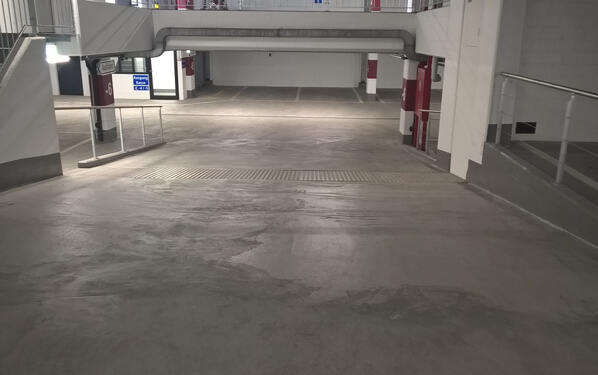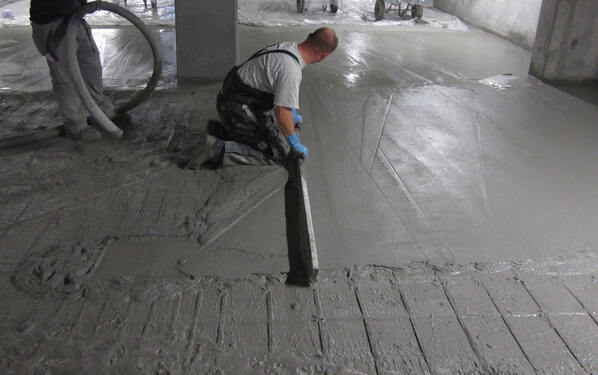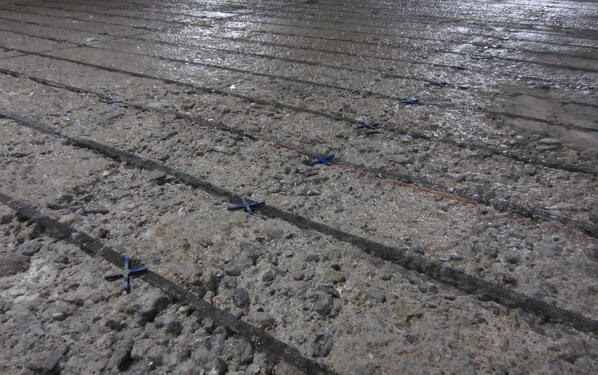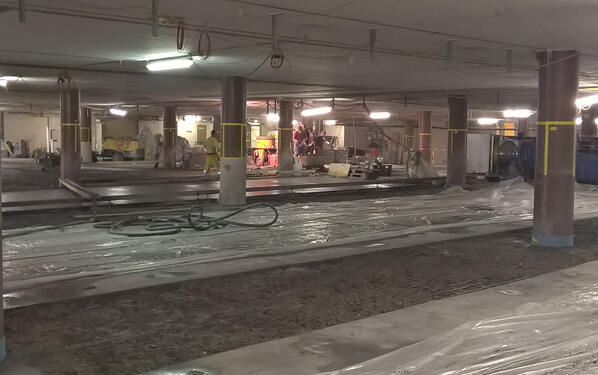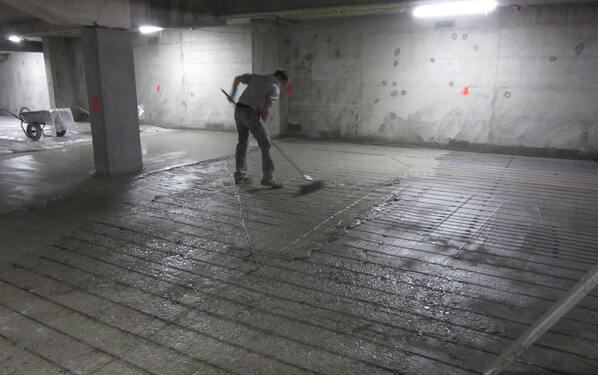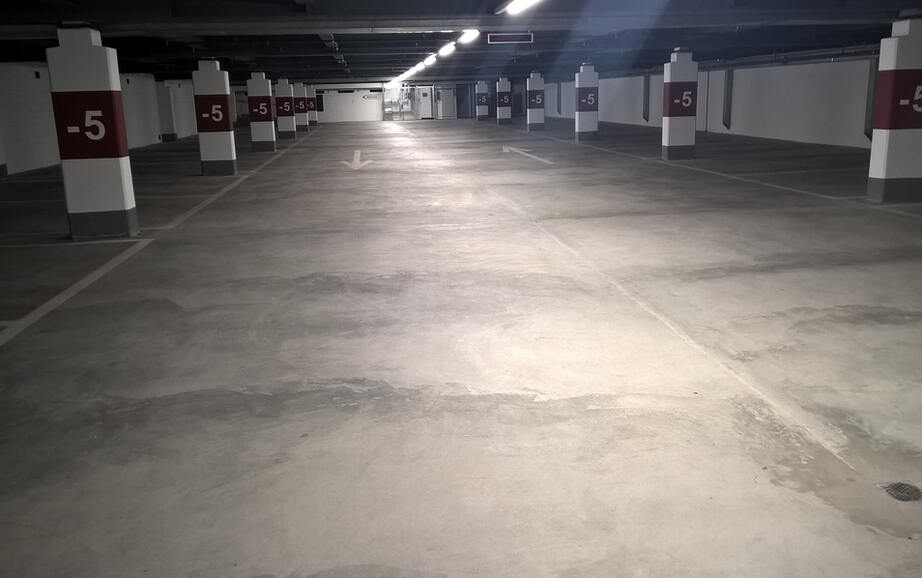
Tons of mortar for concrete repair
Betonreparatur Concrete repConcrete repair with PCI Nanocret R4 SA: Park house refurbishment in the Grindelwald sports center and in Baselair with PCI Nanocret R4 SA: Park house refurbishment in the Grindelwald sports center and in Basel PCI Nanocret R4 S
Tons of mortar for concrete repair
Betonreparatur Concrete repConcrete repair with PCI Nanocret R4 SA: Park house refurbishment in the Grindelwald sports center and in Baselair with PCI Nanocret R4 SA: Park house refurbishment in the Grindelwald sports center and in Basel PCI Nanocret R4 S
Parking garages are exposed to enormous loads. In addition to mechanical stress, they have to withstand the de-icing salts in the splash water of cars in winter. Refurbishment requires in-depth expertise and reliable products. In addition, the closing times should be as short as possible. Refurbishing the parking garage in the Grindelwald sports center and in the city center of Basel also posed a logistical challenge for planners and contractors: the contractors used a total of more than 850 tons of the high-strength repair mortar PCI Nanocret R4 SA.
Built in 1975 under the Grindelwald Sports Center, the parking garage offers around 176 parking spaces on an area of 4,400 square meters. After more than 40 years of use, it was refurbished in 2017. The years had left their mark: Due to unsealed floors, de-icing salts had penetrated the unprotected concrete up to the steel reinforcement and had started the corrosion process of the reinforcement bars by chlorides.
Pitting corrosion due to chloride action
Chlorides do not cause full-surface corrosion on the surface of the reinforcing bars. Pitting corrosion only occurs at individual points. However, the deeper this penetrates into the reinforcing steel, the more it forms real "rust holes" over time. Experts also speak of pitting corrosion. The tricky thing about pitting corrosion is that it is not visible from the outside and can continue to act covertly, since the volume of the steel reinforcement does not increase. In contrast to carbonation, there is a loss of cross-section in the steel reinforcement.
Spalling due to carbonation
Carbonation is defined by experts as the transformation of the cement binder into limestone. A chemical reaction occurs between the cement stone in the concrete and the carbon dioxide in the ambient air: the calcium hydroxide of the cement stone is transformed into calcium carbonate or limestone, and humid surroundings intensify this process. Normally, the pH of the surrounding concrete is above twelve and protects the reinforcing steel from corrosion. Since in carbonated concrete the pH is below nine, the reinforcing steel is no longer protected from corrosion. Because rust has a much larger volume than steel, the diameter of the bars increases over time. This often leads to the fact that the covering concrete starts to spall in individual places.
Professional substrate preparation in case of pitting corrosion
The measured concentration of chlorides in the area of the reinforcing steel was high on the parking floor slabs and the risk of pitting corrosion was high. Because the cross-section of the reinforcing steel, which was greatly reduced by corrosion, endangered the statics of the supporting structure, the process had to be stopped as quickly as possible. For professional refurbishment, processors have to remove the chloride-contaminated concrete down to behind the reinforcing steel. In addition, there is a safety margin to cover fluctuations in the chloride penetration depth. The concrete was removed by means of high-pressure water jetting with a water jet under very high pressure of up to 3000 bar. This procedure represents the ideal substrate preparation for concrete repair: Concrete removal by high-pressure water jetting is not only completely emission-free, but at the same time cleans the exposed reinforcing steel as well as the substrate perfectly from contamination.
Passive or active corrosion protection
Before applying the repair mortar, the reinforcing steel must be protected against new corrosion-promoting substances by passive or active corrosion protection. In passive corrosion protection, a dense corrosion coating on the reinforcing steel forms a separating layer between the corrosion medium and the material to be protected. Active protection, on the other hand, intervenes directly in the corrosion process. One possibility is cathodic corrosion protection (CCP). In this case, processors must ensure that the anode mesh or cable tapes of the CCP are embedded with an anode embedding mortar tested by an accredited laboratory.
Daniel Oberhänsli, Managing Director of suicorr AG, the company commissioned to carry out the cathodic corrosion protection at the Grindelwald Sports Center, explains how it works as follows:
"In cathodic corrosion protection, a less noble material is added to the corrosion system by using sacrificial anodes such as zinc or magnesium. This dissolves, thereby emitting the required protective current so that the metal to be protected does not rust. When using external current anodes, highly resistant materials such as titanium are used as anodes and supplied with the necessary protective current by means of a protective current device. The external protective current supply allows the required protective current to be controlled and monitored. The CCP is thus a protection system and infrastructure monitoring system in one."
Reliable concrete repair with PCI Nanocret R4 SA in the parking garage of the Grindelwald Sports Center
The requirements for concrete repair of statically relevant structural elements are high. Planners and applicators must be able to rely on a permanently reliable repair mortar. At the same time, the repair mortar used for the parking garage of the Grindelwald Sports Center had to meet the requirements of cathodic corrosion protection. Therefore, the municipal administration of Grindelwald as the contractor, together with the commissioned engineering office B+S AG, decided in favor of the high-strength repair mortar PCI Nanocret R4 SA.
For the refurbishment measure, the parking garage under the sports center was closed. However, the ambitious schedule as well as the ban on trucks with a total weight of 40 tons entering Grindelwald village demanded a well thought-out organization of the construction site processes. Around 240 tons of the concrete repair mortar, equivalent to 200 pallets, had to be delivered - first by 40-ton truck to the village entrance, then after reloading onto smaller trucks to the construction site. In addition, the delivery had to be timed to match the daily output of the mortar pump. After mixing the bagged material with water, the processors pumped the mortar over a distance of more than 80 meters onto the parking decks. On the matt damp substrate they first applied a bonding agent made of the PCI Nanocret R4 SA's own material and then placed the mortar "fresh in fresh". This process requires great attention because here the anode net or the cable tapes of the CCP system have to be embedded in the fresh mortar bed. After commissioning, the current for corrosion protection of the reinforcing steel flows through the anode network. The surface of the freshly applied repair mortar PCI Nanocret R4 SA was compacted by the craftsmen with a vibrating beam, evenly troweled and finally smoothed with a walk-behind trowel. Thanks to the cathodic corrosion protection, the client was able to dispense with large-scale surface protection of the parking floor slabs; it was only necessary in the area of the floor/wall connection to protect the surfaces of the concrete walls against new de-icing salt ingress.
Basel Parkhaus City: From hospital to new/fifth parking level
A parking garage refurbishment of at least similar complexity was due in Basel in 2018, at the Parkhaus City in the immediate vicinity of the University Hospital (USB) and the University Children's Hospital of Basel (UKBB). In 2007, the underground parking garage with 900 parking spaces had been modernized and brought up to the latest standards of safety, technology and comfort. More than 460,000 visitors use the parking garage every year and the demand for parking spaces is constantly increasing. For this reason, the city of Basel planned to convert the existing fifth basement level, covering an area of 5,700 square meters, for additional parking spaces. The special thing about it is that it once housed a functioning hospital set up for disaster control. Before carrying out the refurbishment and conversion work, the redevelopers first had to dismantle partition walls, sanitary facilities and floor coverings. At the same time, the planners were already investigating the condition of the existing cement screed: it exhibited insufficient bond adhesion and thus did not meet the requirements for the new use. When the cement screed was removed by ultra-high-pressure water jetting, not only the screed layer came loose, but also partly the upper part of the structural concrete. This was even worse than assumed after the preliminary investigations. As a result, the surface was very irregular in height and had to be reprofiled. The planning office Aegerter & Bosshardt AG, Basel, which was consulted, decided to use a reprofiling mortar for refurbishment. After a break in the work, the substrate was prepared for the installation of PCI Nanocret R4 SA from May 2018.
622 tons of mortar applied under time pressure
Exactly six weeks were still available for the installation of 622 tons of PCI Nanocret R4 SA. As the ongoing operations of the neighboring hospitals had priority, external suppliers were only allowed to access the job site between 5:30 and 7 pm. The second basement level could be used as an intermediate storage area due to the required access height. From there, the contractors distributed the pallets with small transport vehicles via access ramps to the fifth basement level and mixed more than 20 tons of PCI Nanocret R4 SA per day, pumped and leveled the mortar mass according to the planner's specifications for the subsequent parking deck coating. The contractor did an excellent job - the coating could even be started earlier than planned.
Conclusion: One mortar for all applications
Built in 1975 under the Grindelwald Sports Center, the parking garage offers around 176 parking spaces on an area of 4,400 square meters. After more than 40 years of use, it was refurbished in 2017. The years had left their mark: Due to unsealed floors, de-icing salts had penetrated the unprotected concrete up to the steel reinforcement and had started the corrosion process of the reinforcement bars by chlorides.
Pitting corrosion due to chloride action
Chlorides do not cause full-surface corrosion on the surface of the reinforcing bars. Pitting corrosion only occurs at individual points. However, the deeper this penetrates into the reinforcing steel, the more it forms real "rust holes" over time. Experts also speak of pitting corrosion. The tricky thing about pitting corrosion is that it is not visible from the outside and can continue to act covertly, since the volume of the steel reinforcement does not increase. In contrast to carbonation, there is a loss of cross-section in the steel reinforcement.
Spalling due to carbonation
Carbonation is defined by experts as the transformation of the cement binder into limestone. A chemical reaction occurs between the cement stone in the concrete and the carbon dioxide in the ambient air: the calcium hydroxide of the cement stone is transformed into calcium carbonate or limestone, and humid surroundings intensify this process. Normally, the pH of the surrounding concrete is above twelve and protects the reinforcing steel from corrosion. Since in carbonated concrete the pH is below nine, the reinforcing steel is no longer protected from corrosion. Because rust has a much larger volume than steel, the diameter of the bars increases over time. This often leads to the fact that the covering concrete starts to spall in individual places.
Professional substrate preparation in case of pitting corrosion
The measured concentration of chlorides in the area of the reinforcing steel was high on the parking floor slabs and the risk of pitting corrosion was high. Because the cross-section of the reinforcing steel, which was greatly reduced by corrosion, endangered the statics of the supporting structure, the process had to be stopped as quickly as possible. For professional refurbishment, processors have to remove the chloride-contaminated concrete down to behind the reinforcing steel. In addition, there is a safety margin to cover fluctuations in the chloride penetration depth. The concrete was removed by means of high-pressure water jetting with a water jet under very high pressure of up to 3000 bar. This procedure represents the ideal substrate preparation for concrete repair: Concrete removal by high-pressure water jetting is not only completely emission-free, but at the same time cleans the exposed reinforcing steel as well as the substrate perfectly from contamination.
Passive or active corrosion protection
Before applying the repair mortar, the reinforcing steel must be protected against new corrosion-promoting substances by passive or active corrosion protection. In passive corrosion protection, a dense corrosion coating on the reinforcing steel forms a separating layer between the corrosion medium and the material to be protected. Active protection, on the other hand, intervenes directly in the corrosion process. One possibility is cathodic corrosion protection (CCP). In this case, processors must ensure that the anode mesh or cable tapes of the CCP are embedded with an anode embedding mortar tested by an accredited laboratory.
Daniel Oberhänsli, Managing Director of suicorr AG, the company commissioned to carry out the cathodic corrosion protection at the Grindelwald Sports Center, explains how it works as follows:
"In cathodic corrosion protection, a less noble material is added to the corrosion system by using sacrificial anodes such as zinc or magnesium. This dissolves, thereby emitting the required protective current so that the metal to be protected does not rust. When using external current anodes, highly resistant materials such as titanium are used as anodes and supplied with the necessary protective current by means of a protective current device. The external protective current supply allows the required protective current to be controlled and monitored. The CCP is thus a protection system and infrastructure monitoring system in one."
Reliable concrete repair with PCI Nanocret R4 SA in the parking garage of the Grindelwald Sports Center
The requirements for concrete repair of statically relevant structural elements are high. Planners and applicators must be able to rely on a permanently reliable repair mortar. At the same time, the repair mortar used for the parking garage of the Grindelwald Sports Center had to meet the requirements of cathodic corrosion protection. Therefore, the municipal administration of Grindelwald as the contractor, together with the commissioned engineering office B+S AG, decided in favor of the high-strength repair mortar PCI Nanocret R4 SA.
For the refurbishment measure, the parking garage under the sports center was closed. However, the ambitious schedule as well as the ban on trucks with a total weight of 40 tons entering Grindelwald village demanded a well thought-out organization of the construction site processes. Around 240 tons of the concrete repair mortar, equivalent to 200 pallets, had to be delivered - first by 40-ton truck to the village entrance, then after reloading onto smaller trucks to the construction site. In addition, the delivery had to be timed to match the daily output of the mortar pump. After mixing the bagged material with water, the processors pumped the mortar over a distance of more than 80 meters onto the parking decks. On the matt damp substrate they first applied a bonding agent made of the PCI Nanocret R4 SA's own material and then placed the mortar "fresh in fresh". This process requires great attention because here the anode net or the cable tapes of the CCP system have to be embedded in the fresh mortar bed. After commissioning, the current for corrosion protection of the reinforcing steel flows through the anode network. The surface of the freshly applied repair mortar PCI Nanocret R4 SA was compacted by the craftsmen with a vibrating beam, evenly troweled and finally smoothed with a walk-behind trowel. Thanks to the cathodic corrosion protection, the client was able to dispense with large-scale surface protection of the parking floor slabs; it was only necessary in the area of the floor/wall connection to protect the surfaces of the concrete walls against new de-icing salt ingress.
Basel Parkhaus City: From hospital to new/fifth parking level
A parking garage refurbishment of at least similar complexity was due in Basel in 2018, at the Parkhaus City in the immediate vicinity of the University Hospital (USB) and the University Children's Hospital of Basel (UKBB). In 2007, the underground parking garage with 900 parking spaces had been modernized and brought up to the latest standards of safety, technology and comfort. More than 460,000 visitors use the parking garage every year and the demand for parking spaces is constantly increasing. For this reason, the city of Basel planned to convert the existing fifth basement level, covering an area of 5,700 square meters, for additional parking spaces. The special thing about it is that it once housed a functioning hospital set up for disaster control. Before carrying out the refurbishment and conversion work, the redevelopers first had to dismantle partition walls, sanitary facilities and floor coverings. At the same time, the planners were already investigating the condition of the existing cement screed: it exhibited insufficient bond adhesion and thus did not meet the requirements for the new use. When the cement screed was removed by ultra-high-pressure water jetting, not only the screed layer came loose, but also partly the upper part of the structural concrete. This was even worse than assumed after the preliminary investigations. As a result, the surface was very irregular in height and had to be reprofiled. The planning office Aegerter & Bosshardt AG, Basel, which was consulted, decided to use a reprofiling mortar for refurbishment. After a break in the work, the substrate was prepared for the installation of PCI Nanocret R4 SA from May 2018.
622 tons of mortar applied under time pressure
Exactly six weeks were still available for the installation of 622 tons of PCI Nanocret R4 SA. As the ongoing operations of the neighboring hospitals had priority, external suppliers were only allowed to access the job site between 5:30 and 7 pm. The second basement level could be used as an intermediate storage area due to the required access height. From there, the contractors distributed the pallets with small transport vehicles via access ramps to the fifth basement level and mixed more than 20 tons of PCI Nanocret R4 SA per day, pumped and leveled the mortar mass according to the planner's specifications for the subsequent parking deck coating. The contractor did an excellent job - the coating could even be started earlier than planned.
Conclusion: One mortar for all applications
Dato
02.05.2019
Opgave
Park house refurbishment in the Grindelwald sports center and in Basel
By
Grindelwald und Basel
Udførelse
2019
Objektstørrelse
4.400 m²
Produktanvendelse
Nanocret R4 SA
Bygherre
Sportzentrum Grindelwald und in Basel
Din kontaktperson for spørgsmål:
PCI Bauprodukte AG
Im Schachen 291, 5113 Holderbank, Switzerland
Telefon: +41 58 958 31 22
Telefax: +49 58 958 31 22
E-Mail: pci-ch-info@pci-group.eu
www.pci.ch

